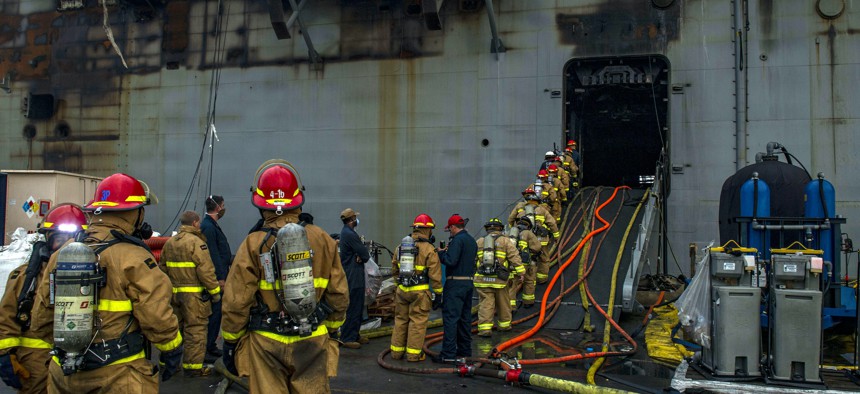
Sailors prepare to board the amphibious assault ship USS Bonhomme Richard (LHD 6) at Naval Base San Diego, July 14, 2020, to support firefighting efforts. U.S. Navy / Mass Communications Specialist 3rd Class Jason Waite
Navy Seeks To Improve Firefighting After ‘Preventable’ Bonhomme Richard Disaster
Naval Safety Center gets a promotion, while ships’ crews will be trained to respond to pierside fires.
The fire that devastated the USS Bonhomme Richard last year was the result of multiple, compounding failures that sufficient oversight and training would have prevented, according to two Navy reports that offer recommendations to prevent another such disaster.
The Navy released two documents Wednesday related to the ship fire and previous fire incidents: a command investigation led by Vice Adm. Scott Conn, the former U.S. 3rd Fleet commander; and a Major Fires Review by the commanders of U.S. Fleet Forces Command and U.S. Pacific Fleet.
“I see the loss of Bonhomme Richard as preventable and wholly unacceptable. The Navy is taking a hard look at our shortcomings through this body of work,” Adm. Bill Lescher, the vice chief of naval operations, told reporters Wednesday.
The fire began in a lower vehicle-storage area of the Bonhomme Richard as it sat pierside for maintenance at Naval Base San Diego in July 2020. The fire burned through 11 of the 14 decks, damaging the ship so badly that the Navy simply sold it for scrap. Seaman Apprentice Ryan Sawyer Mays has been charged with arson.
The command investigation found that the ship was lost “due to an inability to extinguish the fire. In the 19 months executing the ship’s maintenance availability, repeated failures allowed for the accumulation of significant risk and an inadequately prepared crew, which led to an ineffective fire response.”
Four key areas were identified that led to the failures to fight the fire effectively: the material condition of the ship, training and readiness, support from the shore establishment, and oversight.
“An example of how these focus areas combined to result in unacceptable levels of risk is the status of the ship’s Aqueous Film Forming Foam sprinkling system. At no point in the firefighting effort was it used – in part because maintenance was not properly performed to keep it ready and in part because the crew lacked familiarity with capability and availability,” the report said.
The investigation had 139 recommendations, of which the first 25 have already been completed, Lescher said.
The command investigation recommended that 36 people—from the ship’s crew and command team up to different fleet organizations—be considered for further accountability actions because they held some responsibility for the loss of the ship. The list includes Capt. Gregory Thoroman, the ship’s commanding officer; Capt. Mark Nieswiadomy, former commander of Naval Base San Diego; Richard Brown, a now-retired three-star who led Naval Surface Force, U.S. Pacific Fleet; and Rear Adm. William Greene, the fleet maintenance officer for U.S. Fleet Forces Command.
Lescher designated the commander of U.S. Pacific Fleet, Adm. Samuel Paparo, to be the consolidated disposition authority to determine administrative and disciplinary actions for the service members. Recommendations for civilians will be sent to their supervisor.
The major fires review was established in January and looked into 15 major shipboard fires going back to 2008 to determine whether there were any causal trends related to firefighting. The review had 12 major findings and seven “strategic recommendations” for corrective action.
The review found that while Navy warships are generally good at fighting fires at sea, some ships’ commands struggle with the different hazards and challenges of going into and coming out of a maintenance period, Lescher said.
“Most of our commanders and crew tackle these successfully, but some clearly struggle. We need better mechanisms to recognize when our people need help or need intervention. We need to improve the structure that supports them,” he said.
As part of a new damage control industrial certification, ship crews will now be tested, trained, and certified as they enter into a maintenance period, which had not been done before, Rear Adm. Paul Spedero, the commander of Joint Enabling Capabilities Command at U.S. Transportation Command told reporters Wednesday.
“That [certification] will ensure that they are aware of the unique risks that are associated with the maintenance environment, the particular vulnerabilities that are present, as well as how they would work through any mitigations that they have in place such as temporary firefighting equipment or alternate systems,” Spedero said.
Lescher highlighted two key corrective actions that the Navy is taking following the two reports. The first was the establishment of a “Learning to Action Board” to oversee the implementation of the recommendations from the two reports and assess their execution overtime.
The other is elevating and resourcing the Naval Safety Center into a command led by a two-star admiral that reports to the chief of naval operations and advises the Navy Secretary. Leading the Navy’s non-nuclear safety oversight, the new command will conduct audits and spot checks on units and their compliance with safety standards, Lescher said.
The safety command “will provide an ongoing comprehensive view of the Navy safety posture, promote compliance, and evaluate whether lessons learned and best practices are being implemented, sustained and shared across the Navy. The command will provide transparency into the safety status of Navy commands for data collection, analysis and reporting, including modern survey regime that amplifies the voice of our sailors,” he said.




